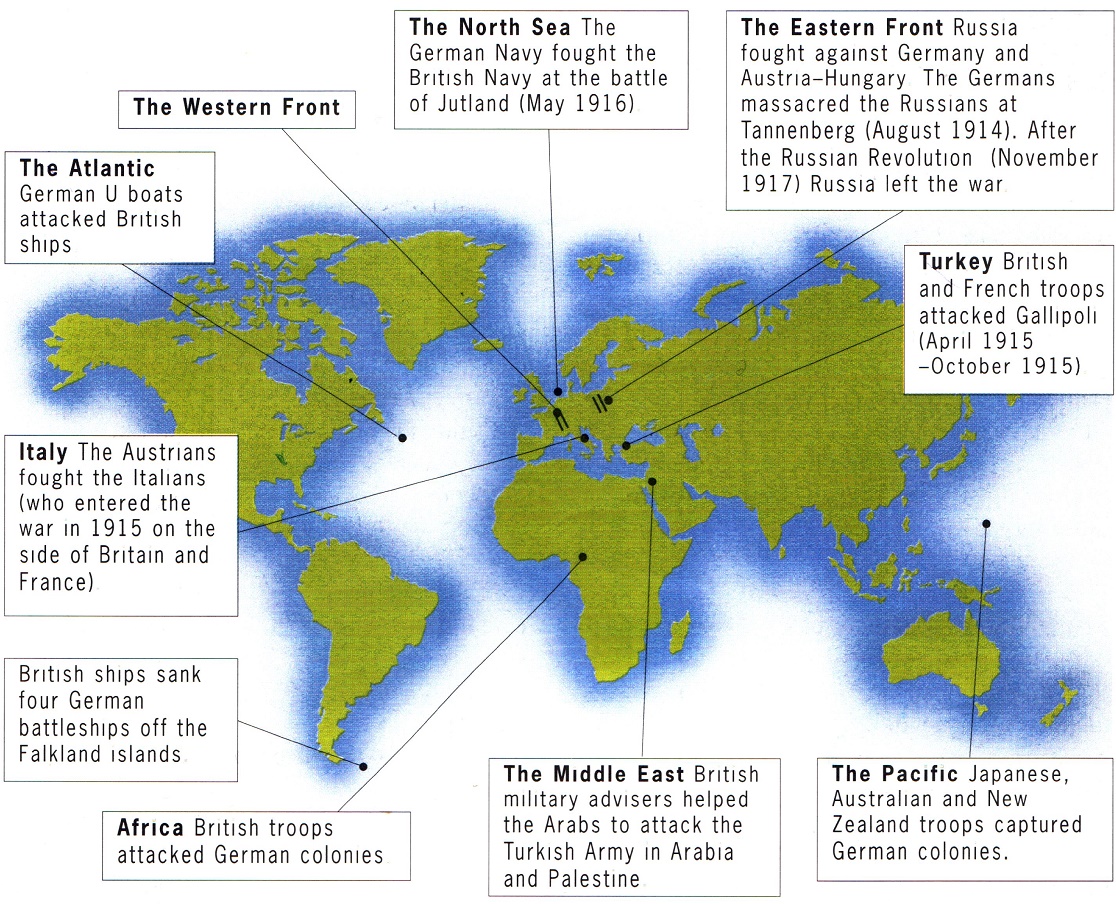
The Course of the First World War

Introduction
The Western Front
The First World War was the first world war. Fighting took place all over the world (see map, Source 1). Troops from Australia, New Zealand, Canada, India, Egypt and the West Indies fought with the Bntish Army. Nevertheless, the most important battles took place in north-eastern France (the 'Western Front').
On 3 August 1914, Germany invaded Belgium. By September 1914, the German Army was only 30 miles from Paris. There, however, at the battle of the Marne, the Germans were stopped. The British and French armies advanced. The Germans dug trenches to defend themselves. The British and French armies were stopped.
At first, as they could no longer go forward, both armies moved sideways. They tried to outflank (get round behind) the other. They dug trenches as they went. They did this until they reached the sea and could not go any further. This part of the war is usually called 'the race to the sea' (September-November, 1914) The result was a line of trenches stretching from Switzerland to the English Channel.
Next, both sides tried to break through the enemy's trenches. It was impossible. Men defended with shells and machine guns. They advanced on foot, with rifles. The war became a deadly stalemate.
By 1916, both sides had realised that they would never break the enemy's lines. They decided simply to try to wear out the enemy by killing more men than they lost. Sometimes they attacked in small raids. Sometimes they made huge attacks – as at the battles of Verdun (February-December 1916), the Somme (July-November 1916) and Passchendaele (July-November 1917). Millions of soldiers died trying to capture a few hundred more yards of mud. This is sometimes called the War of Attrition (wearing down).
In April 1915, at the second battle of Ypres, the Germans became the first people to use poison gas in warfare. The British first used the tank as a weapon at the battle of the Somme in September 1916. The motor car and the aeroplane were first used in warfare on the western front. But nothing could break the stalemate.
Links:
The following websites will help you research further:
GCSE Materials:
• This johndclare.net GCSE page looks at
the
battle of the Somme in huge detail.
• Many historians – along with the TV comedy series
Blackadder Goes Forth – have blamed General Haig for the slaughter of the First World War; this johndclare.net GCSE page looks at
the
role of General Haig in huge detail.
1. Map of the War

Introduction (continued)
Total War
The First World War was the first war to involve whole nations in the fighting. vThe German Navy shelled Hartlepool, Scarborough and Whitby (December 1914). German Zeppelin airships bombed London.
Women, as well as men, went to war. They joined the armed forces as cooks, carpenters and drivers. They served as nurses on the Western Front. At home, they worked in arms factories, and as firemen, bus drivers and navvies.
Both sides tried to starve the other into defeat. German U-boats sank British merchant ships, and the British navy blockaded German ports. The German Navy tried to break the blockade at the sea battle of Jutland (May 1916), but failed. By 1918, many Germans were living on potatoes and berries.
The end of the war
America entered the war in April 1917. In March 1918, therefore, the Germans launched a huge attack, hoping to gain victory before the American Army could get to France. However, this attack collapsed on 8 August 1918. It was the German Army's `Black Day'. The Germans realised that they were going to be defeated. They signed an armistice (ceasefire), which began at 11am on 11 November 1918.
After you have studied this webpage, answer the question sheet by clicking on the
'Time to Work' icon at the top of the page.